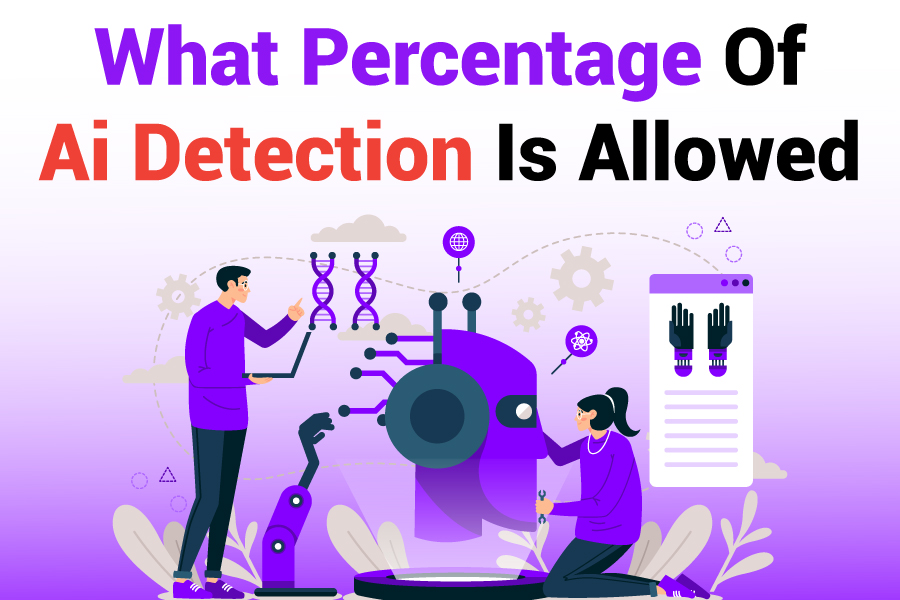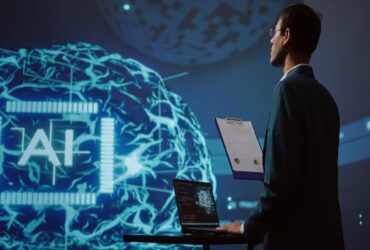Artificial intelligence (AI) has become an integral part of our lives, powering everything from online searches to autonomous vehicles. As AI technology continues to advance, ensuring its accuracy and reliability has become a critical concern. One aspect that often comes under scrutiny is the percentage of AI detection that is allowed in various applications. This refers to the acceptable rate at which AI systems can identify, classify, or recognize objects, patterns, or data points accurately.
In this article, we will explore the concept of AI detection percentages, examining why they are important, how they are determined, and the impact they have on various industries. By the end of this article, you will have a comprehensive understanding of what percentage of AI detection is allowed and why these benchmarks are essential for the safe and effective deployment of AI technologies.
What Percentage Of AI Detection Is Allowed?
The percentage of AI detection allowed varies based on the application and associated risks. For high-stakes areas like healthcare, stricter standards require near-perfect accuracy, while less critical applications may tolerate lower detection rates. Regulatory guidelines and industry standards help ensure AI systems meet necessary safety and performance levels.
Importance And Determination Of AI Detection Percentages
1. Why AI Detection Percentages Matter
AI detection percentages are critical in ensuring the safety, reliability, and effectiveness of AI systems. They determine the accuracy rate at which AI can identify and classify data accurately, which directly impacts the system’s performance. In applications where safety and security are paramount, such as autonomous driving or medical diagnostics, high detection accuracy is non-negotiable. Any deviation or error can lead to severe consequences, ranging from financial losses to life-threatening situations.
2. Determining Acceptable AI Detection Rates
The process of determining acceptable AI detection rates involves rigorous testing and validation. Developers must conduct extensive training using diverse datasets to ensure the AI system can handle various scenarios and data types. Benchmarking against established standards helps in setting these rates. For example, regulatory bodies might mandate a 99% accuracy rate for AI in healthcare diagnostics to minimize false positives and negatives. These standards are often derived from real-world performance data and adjusted as technology evolves.
3. Regulatory Influence on AI Detection Standards
Regulatory bodies play a crucial role in setting and enforcing AI detection standards. Agencies like the FDA for medical devices or the NHTSA for autonomous vehicles establish guidelines that AI systems must meet. These guidelines are based on risk assessments, technological capabilities, and societal impacts. Compliance with these regulations ensures that AI systems are safe for public use and helps build trust among users.
4. Industry-Specific Detection Requirements
Different industries have varying requirements for AI detection accuracy. In finance, for instance, fraud detection systems need high accuracy to prevent losses and ensure security. In contrast, entertainment applications like content recommendation engines may allow for lower accuracy as the stakes are not as high. Understanding these industry-specific requirements helps in developing AI systems that meet the necessary standards and deliver reliable performance.
5. Challenges in Achieving High Detection Rates
Achieving high detection rates in AI systems is not without challenges. One major issue is the quality and diversity of training data. Bias in datasets can lead to inaccurate detection rates and flawed AI performance. Additionally, the complexity of real-world scenarios can make it difficult to maintain high accuracy consistently. Developers must continuously update and refine AI models to address these challenges and improve detection rates over time.
6. Future Trends in AI Detection Standards
As AI technology advances, detection standards are likely to evolve. New algorithms and improved data processing techniques will enhance accuracy and reliability. Additionally, ongoing research in areas like explainable AI and ethical AI will influence future detection standards, ensuring that AI systems are not only accurate but also transparent and fair.
Setting AI Detection Standards
- Regulatory Guidelines: Regulatory bodies such as the FDA, NHTSA, and others set stringent guidelines for AI detection standards, ensuring safety and reliability in critical applications. These guidelines are often based on thorough risk assessments and real-world data, and they are periodically updated to reflect advancements in AI technology and emerging risks.
- Industry Benchmarks: Different industries establish their benchmarks for AI detection. In healthcare, benchmarks are exceptionally high due to the potential impact on patient health. In contrast, industries like entertainment or marketing may have more lenient benchmarks as the consequences of errors are less severe. These benchmarks help maintain a balance between innovation and safety.
- Validation and Testing Processes: Before AI systems are deployed, they undergo extensive validation and testing processes to ensure they meet the required detection standards. This involves using diverse datasets and real-world scenarios to test the AI’s performance. Continuous testing and iteration are essential to maintain high detection rates and adapt to new challenges and data.
- Impact on User Trust: High AI detection rates are crucial for building and maintaining user trust. When AI systems perform reliably, users are more likely to adopt and rely on them. Conversely, frequent errors can erode trust and hinder the widespread adoption of AI technologies. Ensuring high detection accuracy helps in gaining user confidence and driving the success of AI applications.
- Evolving Standards with Technology: As AI technology continues to evolve, detection standards must also adapt. Innovations in machine learning algorithms, data processing, and AI model training contribute to improving detection accuracy. Regulatory bodies and industry stakeholders must stay abreast of these developments to ensure standards remain relevant and effective.
Impacts Of AI Detection Standards
The impacts of AI detection standards extend across various sectors, influencing safety, efficiency, and user experience. High detection accuracy ensures reliability and minimizes risks in critical applications.
- Healthcare: High detection standards reduce diagnostic errors and improve patient outcomes.
- Autonomous Vehicles: Stringent standards enhance safety and reduce accidents.
- Finance: Accurate fraud detection protects against financial losses.
- Security: Reliable detection rates enhance surveillance and threat detection.
- Entertainment: High detection standards improve user experience and engagement.
Challenges In AI Detection And Solutions
One of the major challenges in achieving high AI detection rates is the presence of bias in training data. Bias can stem from various sources, including historical data, data collection methods, and inherent biases in society. Addressing this challenge requires a multifaceted approach. Developers must ensure diverse and representative datasets and implement techniques to mitigate bias in AI models.
Another significant challenge is the complexity of real-world environments. AI systems must be able to handle a wide range of scenarios and data variations. This requires robust training processes and continuous model refinement. Techniques such as transfer learning and data augmentation can help improve AI performance in complex environments.
Finally, there is the challenge of maintaining transparency and explainability in AI systems. Users and regulators need to understand how AI systems make decisions to trust their accuracy. Explainable AI techniques can provide insights into the decision-making process, enhancing trust and acceptance of AI technologies.
Ensuring High AI Detection Standards
- Importance of Rigorous Testing: Rigorous testing processes are crucial in ensuring high AI detection standards. These processes involve extensive validation using diverse datasets to assess AI performance under various conditions.
- Role of Continuous Improvement: Continuous improvement is essential for maintaining high detection rates. AI models must be regularly updated and refined to address new challenges and data variations.
- Collaboration with Regulatory Bodies: Collaboration with regulatory bodies ensures compliance with established standards and helps in setting new benchmarks. This collaboration is vital for maintaining safety and reliability in AI applications.
- Addressing Ethical Considerations: Ethical considerations play a significant role in setting AI detection standards. Ensuring fairness, transparency, and accountability in AI systems helps build trust and acceptance among users.
- Future Directions: Future directions in AI detection standards include the integration of new technologies and methodologies to enhance accuracy and reliability. Ongoing research and development will continue to shape the landscape of AI detection standards.
Conclusion
As AI continues to integrate into various aspects of our lives, understanding and adhering to detection standards will remain paramount. These standards ensure that AI systems are safe, reliable, and effective in their respective applications. By continuously improving and updating detection rates, developers and regulators can address emerging challenges and leverage new technologies to enhance AI performance. Ensuring high detection accuracy not only builds user trust but also paves the way for innovative AI applications across industries.
FAQ’s
What Percentage Of AI Detection Is Considered Acceptable In Healthcare?
In healthcare, AI detection accuracy often needs to be above 95% to ensure patient safety and reliable diagnostics.
How Are AI Detection Standards Set?
AI detection standards are set by regulatory bodies and industry benchmarks based on risk assessments, technological capabilities, and societal impacts.
Why Is High AI Detection Accuracy Important?
High AI detection accuracy is crucial for ensuring the reliability and safety of AI systems, particularly in critical applications like healthcare and autonomous driving.
What Are Some Challenges In Achieving High AI Detection Rates?
Challenges include bias in training data, the complexity of real-world environments, and maintaining transparency and explainability in AI systems.
How Do Regulatory Bodies Influence AI Detection Standards?
Regulatory bodies establish guidelines and standards that AI systems must meet, ensuring safety and reliability in public use. They also update these standards to reflect advancements in technology and












































Leave a Reply